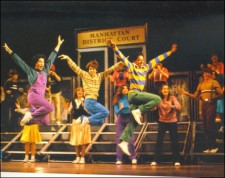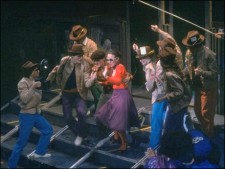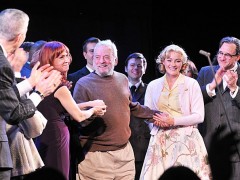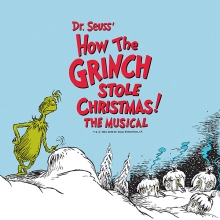Filichia Features: Merrily Does Roll Along
Filichia Features: Merrily Does Roll Along
Thirty-one years ago this week, Broadway saw the last of Merrily We Roll Along.
Granted, the then-new 1981 Stephen Sondheim musical had a hard act to follow: Sweeney Todd, the 1979 musical (or opera, if you insist) that most everyone agrees is the composer-lyricist’s masterpiece.
So Merrily closed – after 16 performances. While word-of-mouth during six weeks of previews revealed a musical that was still finding its way, no one would have predicted so short a run.
After all, by 1981, Sondheim had had five consecutive stunning productions: Company, Follies, A Little Night Music, Pacific Overtures and the aforementioned Sweeney Todd. Didn’t he also have enough of a following that would ensure a decent run for anything he’d bring to Broadway?
Hey, the esoteric (but brilliant) Pacific Overtures -- whose action began in remote 1853 Japan – managed to run five months; wouldn’t the far more accessible MERRILY -- set in the Broadway and Hollywood of the present and recent past -- be able to make at least six or seven?
Compared to all other musicals that Sondheim wrote, none would play to so few audiences except for Anyone Can Whistle in 1964. But back then, Sondheim wasn’t yet esteemed as both a composer and lyricist and had no particular public that was interested in what his next effort would be.

But Merrily? Take it from someone who attended the first preview: virtually every person I knew who lived in New York and cared about musical theatre was in the house. No one could even wait for the second preview. With interest such as this, the show had to have a run.
Comparisons with Anyone Can Whistle didn’t mean much, anyway, because that was a far more unorthodox show, dealing with madness, be it feigned or genuine. But with Merrily, Sondheim, co-producer and director Harold Prince and bookwriter George Furth had to be more at home with its examination of the underbelly of show business; this was, to say the least, territory well-known to these veterans.
Their “hero” (and the word must be used loosely) was composer Franklin Shepard. We met him as a young man in 1957, when expected to write great Broadway musicals with friend and lyricist Charley Kringas. They did provide the score to one commercial hit that was as big as “Funny Girl, Fiddler and Dolly combined.” But while Charley wanted to push the art form forward (as Sondheim and Prince had done in real life), Franklin wasn’t interested. The result: by 1980, he had long sold out to an easy life in La-La Land producing forgettable movies, pursuing multiple romances and not realizing that ol’ friend Mary Flynn might well have been the woman who loved him the most.

The musical was based on a 1934 play of the same name by George S. Kaufman and Moss Hart. That Sondheim was drawn to it wasn’t surprising. His first professional job in the theater was working as a gofer on Allegro, the 1947 Rodgers-and-Hammerstein flop that dealt with the same theme. There, however, audiences saw Doctor Joseph Taylor, Jr. move to the big city (mostly because of his wife’s venal influence) only to wind up treating wealthy hypochondriacs. Taylor was constantly haunted by the thought that he should have stayed in his small home town which he preferred. There he could have ministered to poor people who really needed him.
Allegro, however, was increasingly grim because of its steady downward spiral, as Taylor became more and more bogged down in the life he had no interest in leading. Act One was charming; Act Two a downer.
Merrily didn’t have that problem – because it went backwards in time, beginning in 1980 and steadily going backwards to 1957. As a result, the dour material was dispensed with early on; the second act was full of charm, loyalty and optimism.
But some theatergoers couldn’t warm up to Franklin Shepard. Neither could the critics, who made that plain in their not-good reviews.
Go fight the city’s hall of critics. Two of the four lead producers -- Harold Prince and Robert Fryer – had sponsored dozens of Broadway productions in the previous 30 years. Both had fought the good fight for many less-than-well-received shows, and found that keeping them running meant simply wasting good money after bad. And given that the reviews for Merrily gave them precious little for pull-quotes, they knew that earning back the millions already spent would be impossible. So they took Merrily off the boards after a mere two weeks. By closing it so quickly, they were essentially saying, “You don’t like us? Fine. We’ll go away. We know when we’re not wanted.”

And in doing so, they did the show the best favor they could.
Had Merrily run, say, the 161 performances that 1966 also-ran Walking Happy had amassed, much of its mystique would have been lost. Merrily would have been shown to be a musical that couldn’t find (or please) an audience. The quick flop made everyone wonder … could it possibly have caught on? Did the producers overact?
Directors who hadn’t seen it – and that meant most everyone around the world – now pondered, “How bad could it be? Let me take a look at it and see what I can do with it.”
Thus began Merrily's renaissance. Since I attended that first Broadway preview (and the show’s closing night), I’ve seen nine productions in conservatories, colleges, community theaters and professional outlets too, from the District of Columbia to Ohio, Florida and Pennsylvania.

And it works. What other two-week flop has had four cast recordings? A look at them reveals how much work has been done on the show over the years. Indeed, Merrily has had more facelifts than Joan Rivers, and the show that’s now licensed is not the one that opened on Broadway. It is, however, the one that got strong reviews and vociferous audience cheers when it was produced at Encores! last year.
Many said that the original 1981 production erred in casting teens whose Broadway experience was mostly seeing shows rather than appearing in them. As a result, the kids seemed perilously young for the show’s first act. Most productions since have cast adults, but I’d like to see a production that features middle-aged men and women in the first act and younger ones in the second.
It’s one of the few directorial concepts that (at least to my knowledge) hasn’t been tried. But here’s one of the smartest made on Merrily, courtesy of director Steve Velardi in a 2005 production that featured N.Y.U. students.
He started the show by having Franklin Shepard at the edge of the stage, looking down as if he were perched on a very high building. The sound of wind helped the illusion, too.
From the anguished expression on actor Charles Bonnin’s face, we knew that Franklin was contemplating suicide. What got him to this point? That question would be answered in the musical that followed in which Frank’s whole life flashed before him.
All this was accomplished without Velardi’s changing a word of the script or a single lyric – which, of course, is not allowed in any licensed production.
Now you take a look at the script and score, the latter of which no one ever undervalued; Sondheim’s warmest-ever score got the show’s only Tony nomination. See how the words and music inspire you. Chances are that they will, as they have so many others.
If the rewritten show that’s now licensed had opened on Broadway in 1981, the reception and run would have been a great deal better. But maybe you’ll be the one who comes up with an even better idea that will make Merrily both rock and roll back to Broadway.

You may e-mail Peter at pfilichia@aol.com. Check out his weekly column each Tuesday at www.masterworksbroadway.com and each Friday at www.kritzerland.com. His newest book, Broadway Musical MVPs, 1960-2010: The Most Valuable Players of the Past 50 Seasons, is now available through Applause Books and at www.amazon.com.


























